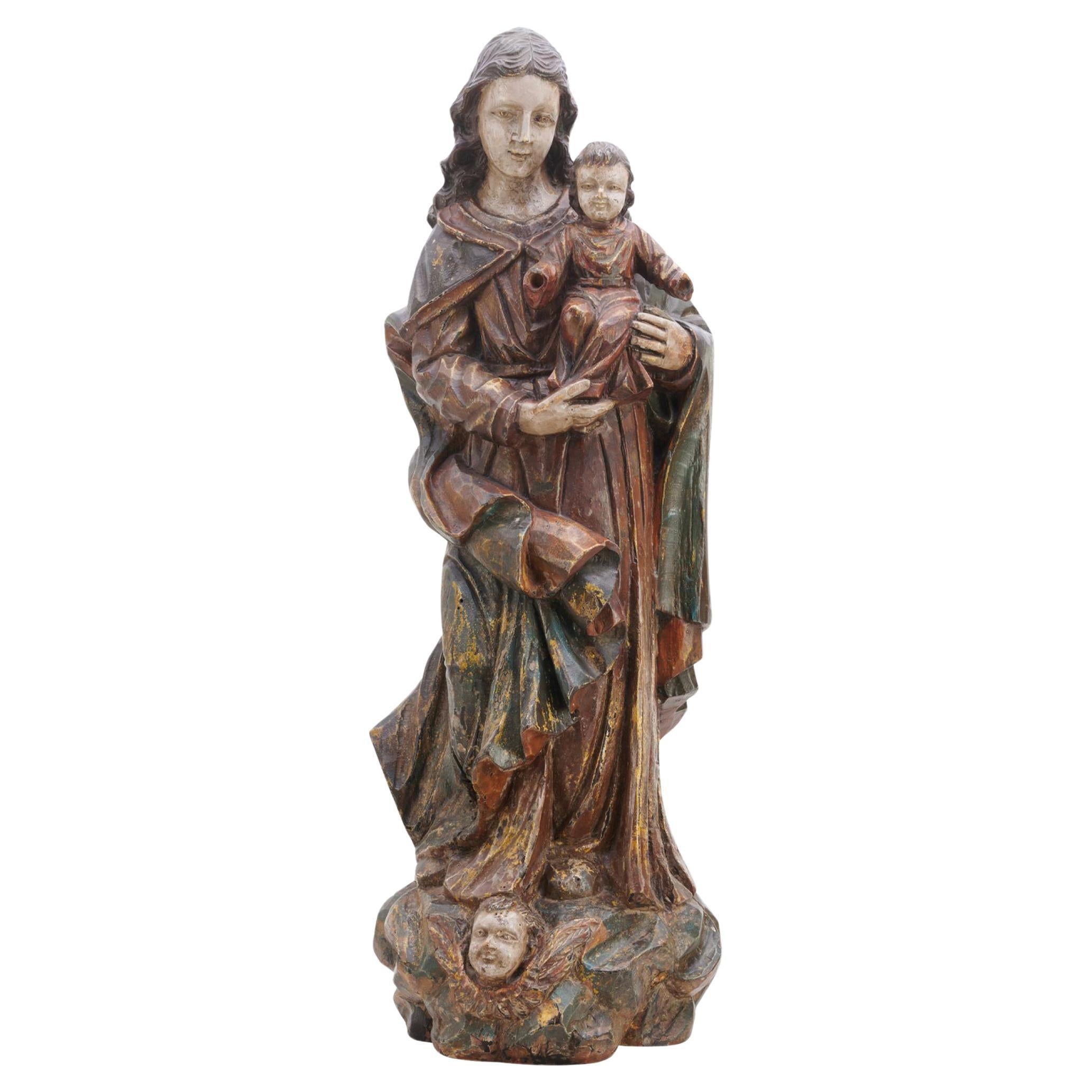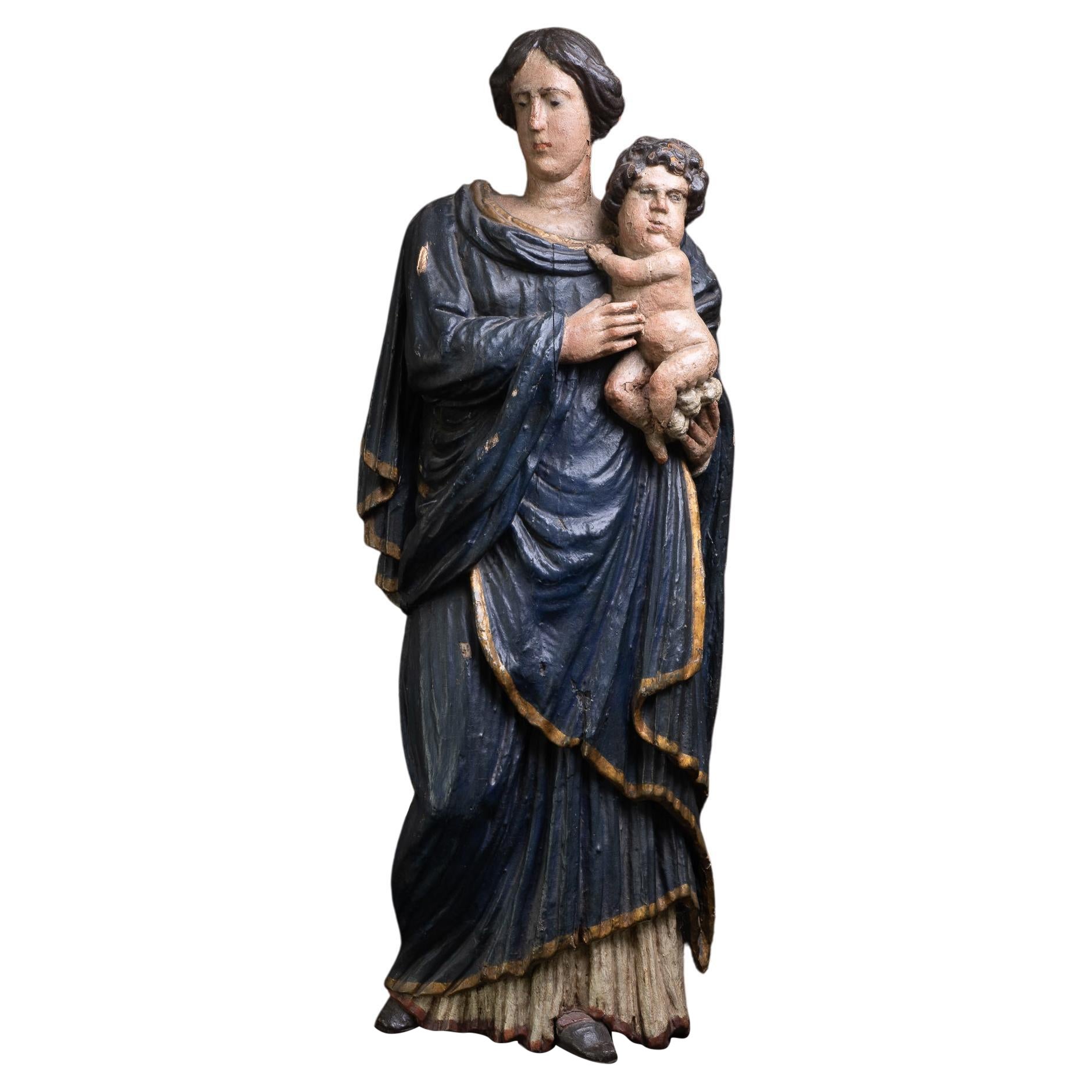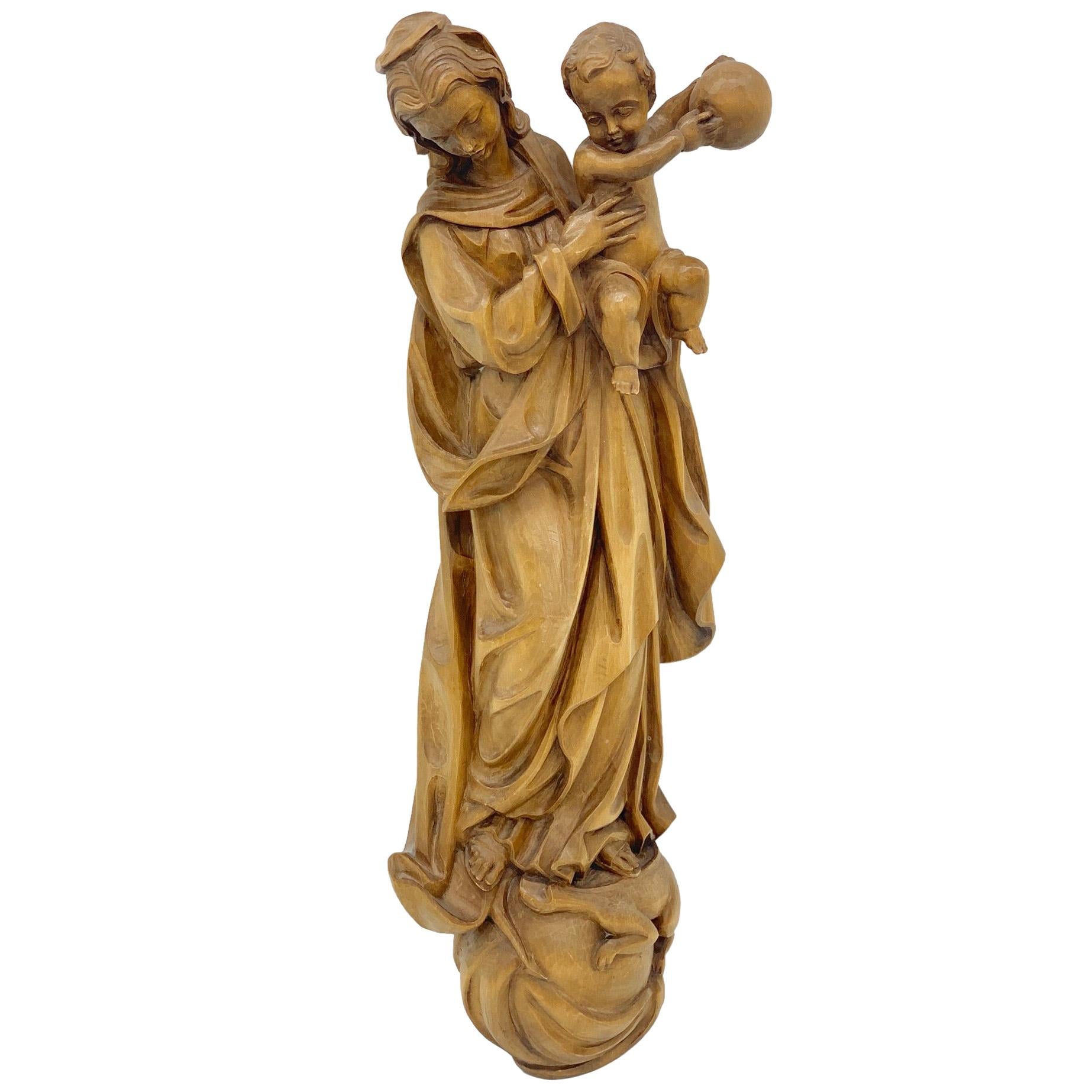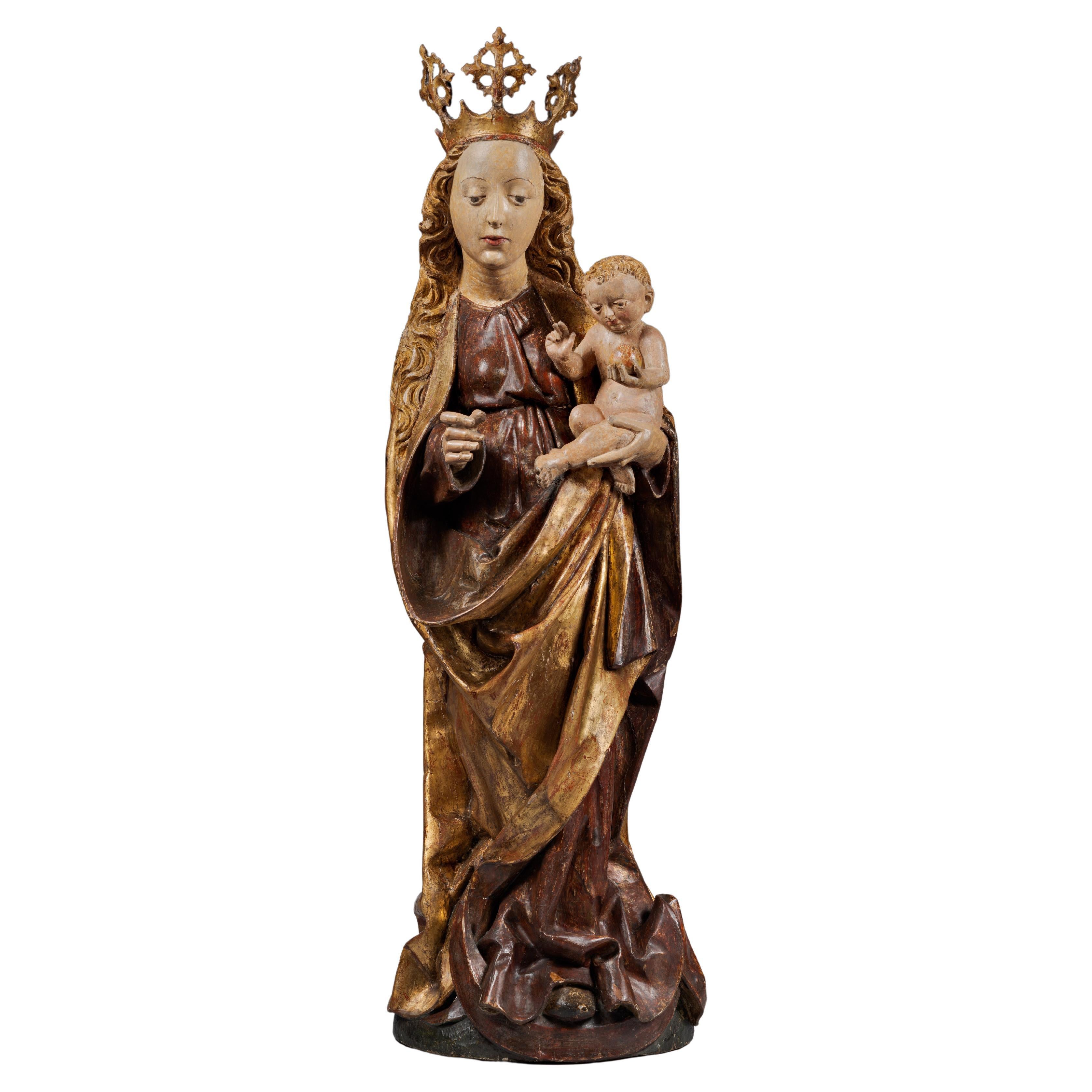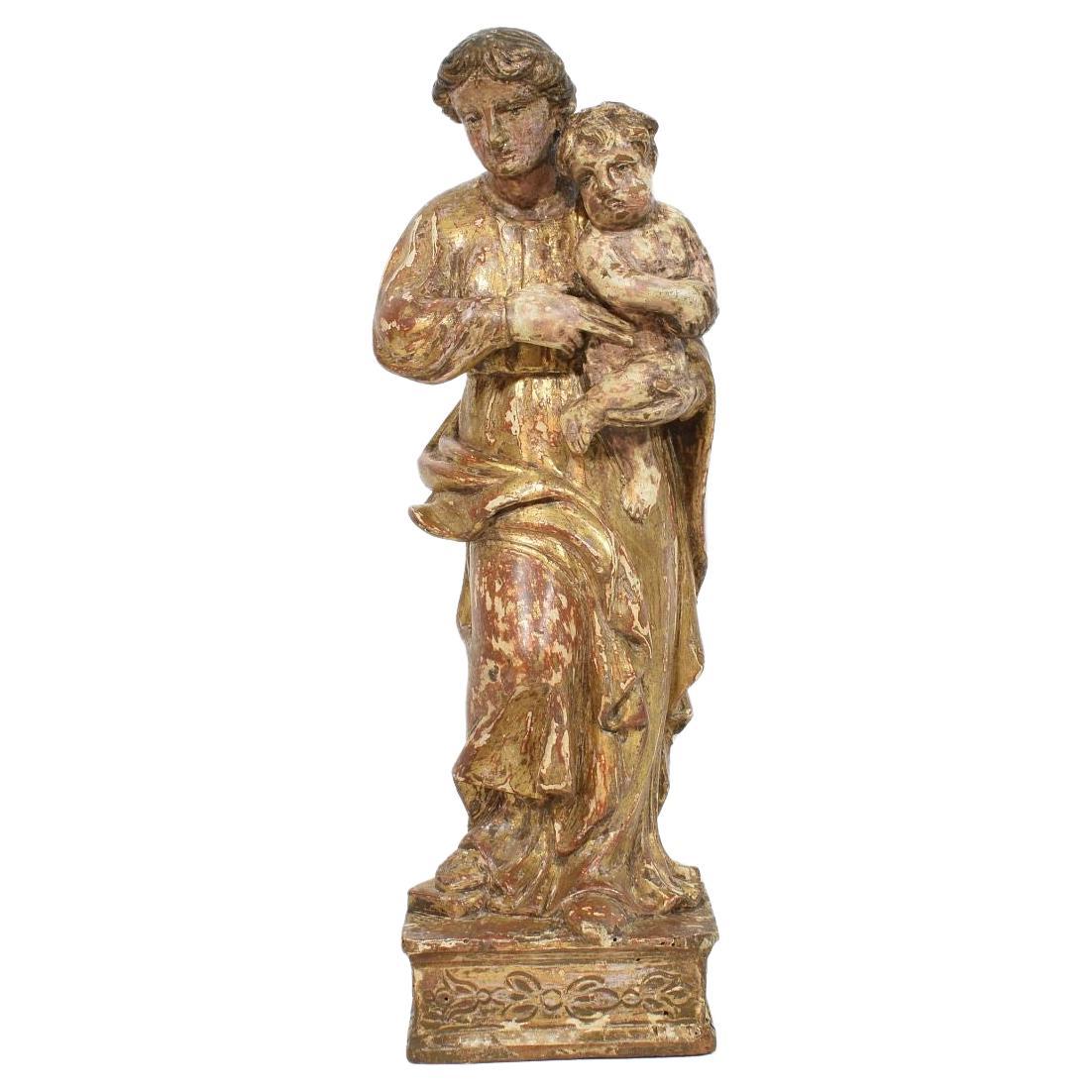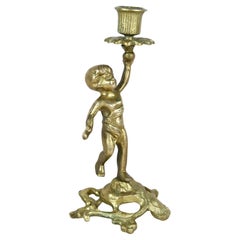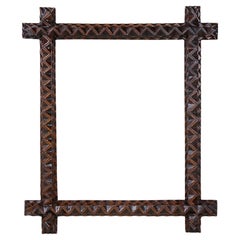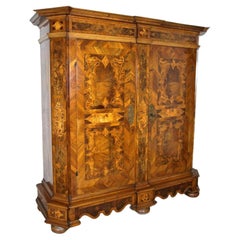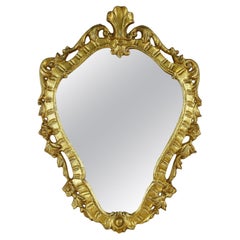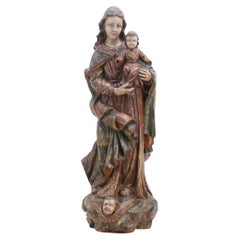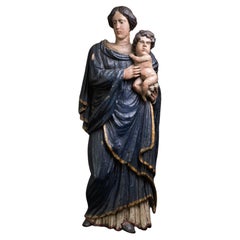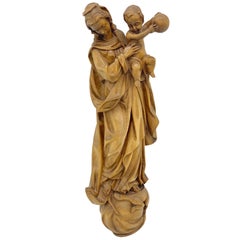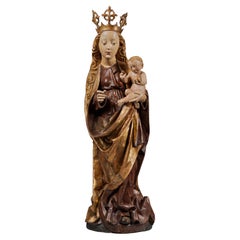Items Similar to 18th Century Polychrome Virgin & Child Wall Sculpture, Handcarved, AT ca. 1760
Want more images or videos?
Request additional images or videos from the seller
1 of 18
18th Century Polychrome Virgin & Child Wall Sculpture, Handcarved, AT ca. 1760
$3,600
£2,733.57
€3,126.04
CA$5,029.72
A$5,594.15
CHF 2,921.09
MX$68,074.84
NOK 37,306.79
SEK 34,987.18
DKK 23,330.80
Shipping
Retrieving quote...The 1stDibs Promise:
Authenticity Guarantee,
Money-Back Guarantee,
24-Hour Cancellation
About the Item
Exceptionally beautiful, polychromed figural baroque wall sculpture from the period around 1760 in Austria. By showing real craftsmanship, this fantastic looking, sacred wall sculpture was artfully hand carved out of a solid piece of basswood and depicts the blessed virgin Mary with her child. A really impressive, large example of sacred art, which was part of an old chapel in lower Austria. The outstanding coloration covered with this charming, very old patina, finalizes this incredible version of a famous "virgin & child" depiction. On the backside you will find a small ring for wall mounting. A remarkable, one of a kind baroque wall figurine/ sculpture from the mid 18th century in Austria. Definitely an item you won´t be able to purchase everyday.
- Dimensions:Height: 23.62 in (60 cm)Width: 6.69 in (17 cm)Depth: 4.72 in (11.99 cm)
- Style:Baroque (Of the Period)
- Materials and Techniques:
- Place of Origin:
- Period:
- Date of Manufacture:1760
- Condition:Wear consistent with age and use. *incredible original condition - only the ring on the back has been renewed.
- Seller Location:Lichtenberg, AT
- Reference Number:Seller: VC-WS11stDibs: LU1553241421632
About the Seller
5.0
Platinum Seller
Premium sellers with a 4.7+ rating and 24-hour response times
Established in 2015
1stDibs seller since 2015
384 sales on 1stDibs
Typical response time: <1 hour
- ShippingRetrieving quote...Shipping from: Lichtenberg, Austria
- Return Policy
Authenticity Guarantee
In the unlikely event there’s an issue with an item’s authenticity, contact us within 1 year for a full refund. DetailsMoney-Back Guarantee
If your item is not as described, is damaged in transit, or does not arrive, contact us within 7 days for a full refund. Details24-Hour Cancellation
You have a 24-hour grace period in which to reconsider your purchase, with no questions asked.Vetted Professional Sellers
Our world-class sellers must adhere to strict standards for service and quality, maintaining the integrity of our listings.Price-Match Guarantee
If you find that a seller listed the same item for a lower price elsewhere, we’ll match it.Trusted Global Delivery
Our best-in-class carrier network provides specialized shipping options worldwide, including custom delivery.More From This Seller
View All19th Century Sculptural Firegilt Baroque Revival Brass Candleholder, AT ca. 1880
Located in Lichtenberg, AT
Decorative 19th century sculptural candleholder from the so-called "Baroque revival" period around 1880. Made of solid, fire gilt brass, this artfully crafted candleholder from the s...
Category
Antique Late 19th Century Austrian Baroque Revival Candlesticks
Materials
Brass
Tramp Art Rustic Photo/ Picture Frame Hand Carved, Austria circa 1880
Located in Lichtenberg, AT
One of a kind Tramp Art photo frame from the period in Austria around 1880. Elaborately hand carved out of bass wood this rustic photo frame shows an exc...
Category
Antique Late 19th Century Austrian Picture Frames
Materials
Blown Glass, Softwood
18th Century Nutwood Baroque Cabinet With Inlay Works , Austria ca. 1770
Located in Lichtenberg, AT
Remarkable 18th century nutwood baroque cabinet out of Austria around 1770. This absolutely artfully handcrafted baroque cabinet was part of the inventory of a private castle - more ...
Category
Antique Late 18th Century Austrian Baroque Cabinets
Materials
Maple, Nutwood, Poplar, Walnut
Late 18th Century Gilt Baroque Wall Mirror, Handcarved - Italy ca. 1790
Located in Lichtenberg, AT
Elegant 18th century gilt wall mirror from the late baroque period around 1790 in Italy. The artfully handcarved, partly open worked frame shows a lovely gold leaf plated surface and is adorned by elaborately carved floral motives, covered by an amazing looking patina. The highlight builds the large, slightly forward tilted top carving. Red shimmering spots that shine through the slightly abrased surface are caused by the so-called "bolus", the substrate/ ground for gilding and confer this late baroque wall mirror an extravagant and luxurious appearance at the same time. The backside is closed with an old card board and a metal ring makes wall mounting easy. An extraordinary shaped, elegant over 230 years old antique wall mirror...
Category
Antique Late 18th Century Italian Baroque Wall Mirrors
Materials
Softwood, Giltwood
Pair Of 19th Century Italian Gilt Wall Mirrors, Handcarved - IT ca. 1850
Located in Lichtenberg, AT
Highly decorative, remarkable pair of amazingly crafted gilt Italian wall mirrors from the mid 19th century. Elaborately hand carved out of basswood around 1850, these outstanding an...
Category
Antique Mid-19th Century Italian Rococo Revival Wall Mirrors
Materials
Mirror, Softwood
Handcarved Tramp Art Photo Frame Rustic Style, Austria circa 1900
Located in Lichtenberg, AT
Beautiful, extraordinary designed Tramp Art photo frame from the very early 20th century in Austria. Elaborately made out basswood around 1900, t...
Category
Early 20th Century Austrian Rustic Picture Frames
Materials
Glass, Softwood
You May Also Like
A Carved Polychrome Painted Figure of the Virgin and Christ, 18th Century
Located in ARMADALE, VIC
A Carved and Polychrome-Painted Group of the Virgin and Christ, 18th Century
The modelled standing in robes holding the Christ child, on a rockwork base with a seraphim mask to the ...
Category
Antique 18th Century French Baroque Figurative Sculptures
Materials
Hardwood
18th C, Southern France, Madonna and Child, Carved and Polychrome Wood
Located in Leuven , BE
Although the 18th century, the period of the Enlightenment in France, spawned thinkers who criticised the privileges of the clergy and the truthfulness of certain dogmas, the Roman Catholic faith was very much present in everyday life. Since king Louis XIV had issued the Edict of Fontainebleau in 1685, Protestantism was banned. This Madonna with child illustrates the daily practice of faith. Like many 18th-century Madonna statues...
Category
Antique 18th Century French Figurative Sculptures
Materials
Wood
Madonna with Child Wall Sculpture Beautiful Woodwork, 20th Century
Located in DE
Madonna with child wall sculpture beautiful woodwork, 20th century. Linden wood with attention to detail.
Category
20th Century European Baroque Figurative Sculptures
Materials
Wood
Polychrome carved wood Virgin and Child from the 15th Century
Located in Saint-Ouen, FR
POLYCHROME CARVED WOOD VIRGIN AND CHILD FROM THE 15TH CENTURY
ORIGIN: SOUTH GERMANY, SWABIA, NUREMBERG REGION
PERIOD: 15th CENTURY
Height: 94,6cm
Width : 28 cm
Depth : 18 cm
Lime wood
Original Polychromy
Good state of conservation
From 1430 onwards, sculpture underwent a profound stylistic renewal which continued until 1530, the so-called late Gothic period. In the Germanic countries, original sculptures flourished in an expressive and sensitive vein.
This renewal was inspired by the art of Nicholas of Leiden, who was active in Strasbourg in the 1460's. His style broke with the refined and delicate art of the international Gothic style in force throughout Europe around 1400. The figures became more authentic and realistic. The bodies became denser. Clothes are animated by deep, broken folds, the fabrics are heavy and have a great decorative value. In addition, the polychromy is intended to be illusionistic. The painting makes it possible to restore the texture of the materials, the richness of the textiles and the natural skin tone of the characters.
The dissemination of images through engraving and the great mobility of the artists led to the success of this style, which conquered the Upper Rhine, Swabian, Tyrolean and Franconian regions, contributing to the formation of a common stylistic identity in these regions. The economic boom in the flourishing German cities was conducive to the development of original production. Attracted by this prosperity, numerous workshops were set up in order to meet the orders of religious communities, the Church and the laity, including a clientele of middle-class rockers.
This precious Virgin and Child is depicted standing on a crescent moon, her head encircled by a crown of tall flowers. Her long wavy hair spreads over her shoulders, framing her beautiful oval face. Under fine eyebrows drawn with a brushstroke, her almond-shaped, slightly drooping eyes look at the Child with infinite softness. She is dressed in a long red dress with a rounded neckline, belted under the chest. The heavy fabric of her dress spreads out in broken folds at her feet. On her shoulders she wears a golden cloak. The drapery has deep folds. She holds out her right hand while she holds the Christ Child with her left.
Christ, with his well-defined hair, is naked. His cheeks are highlighted with red, he holds an apple in his left hand and with the other hand makes a sign of blessing towards the faithful.
Virgins with Child on a crescent moon were very popular in the second half of the 15th century, especially as the central subject of altarpieces in southern Germany and Austria. The crescent moon on which Mary is standing is reminiscent of the Woman of the Apocalypse. Often equated with the Virgin Mary.
This episode is taken from the Book of Revelation (12:1-6)
1 Then a great sign appeared in heaven: a woman clothed with the sun, with the moon under her feet and a crown of twelve stars on her head. ; 2 She was pregnant, and she cried out because she was in labor, in pain from giving birth. ; 3 Then another sign appeared in heaven: it was a great fiery red dragon, with seven heads and ten horns, and seven royal crowns on his heads. ; 4 His tail swept down a third of heaven's stars and threw them to the earth. The dragon stood in front of the woman who was about to give birth so that when she gave birth, he might devour her child. ; 5 She gave birth to a son, a male child who is to rule all the nations with an iron rod. Her child was snatched up to God and his throne. ; 6 Then the woman fled into the desert, where God has prepared a place for her. There she will be taken care of for one thousand two hundred sixty days.
Some theologians see in this woman a reference to the Virgin Mary and in the child, Jesus.
This remarkable work is a very fine example of sculpture from Swabian workshops in the last decades of the 15th century. It presents all the characteristic stylistic elements: a highly girdled silhouette, an abundant drapery with angular folds, but also a great physical presence accentuated by the polychromy that restores the anatomical details. This group is made of a wooden log. The deep folds of the drapery highlight the movement of the Virgin holding the child.
Bibliography :
Sophie Guillot de Suduiraut, Dévotion et Séduction, Sculptures souabes des musées de France, vers 1460-1530, Paris musée du Louvre-Éditions somogy, 2015
“Revelation 12 - Common English Bible...
Category
Antique 15th Century and Earlier German Gothic Figurative Sculptures
Materials
Wood
18th Century Italian Neoclassical Carved Wooden Madonna With Child
Located in Buisson, FR
Beautiful weathered neoclassical Madonna with child. Traces of original color and gilding visible,
Italy, circa 1760-1800.
Weathered small losses and old repairs.
More photo's availa...
Category
Antique 18th Century Italian Neoclassical Religious Items
Materials
Wood
$808 Sale Price
50% Off
Virgin of Mercy Statue, Religious Art, Baroque Style, 18th Century
Located in Lisbon, PT
An 18th Century figure of the Pietà or the Virgin of Mercy, carved in polychrome wood.
Our Lady appears seated on the throne with her head covered by a mantle, supporting the inert...
Category
Antique 18th Century Portuguese Baroque Religious Items
Materials
Silver
$5,896 Sale Price
20% Off
More Ways To Browse
Antique Ring Mount
Antique Ring Mountings
Antique Ring Mounts
Baroque Virgin Sculpture
Blessed Virgin Mary
Anglo India Doors
Antique 13 Star American Flag
Antique 7 Day Clock
Antique 7 Drawer Desk
Antique Bronze Gong
Antique Copper Nails
Antique Crystal Dishes
Antique Glass Swan Bowl
Antique Harvester
Antique Jewelers Desk
Antique Obi
Antique Onyx Mantel Clocks
Antique Petticoat
